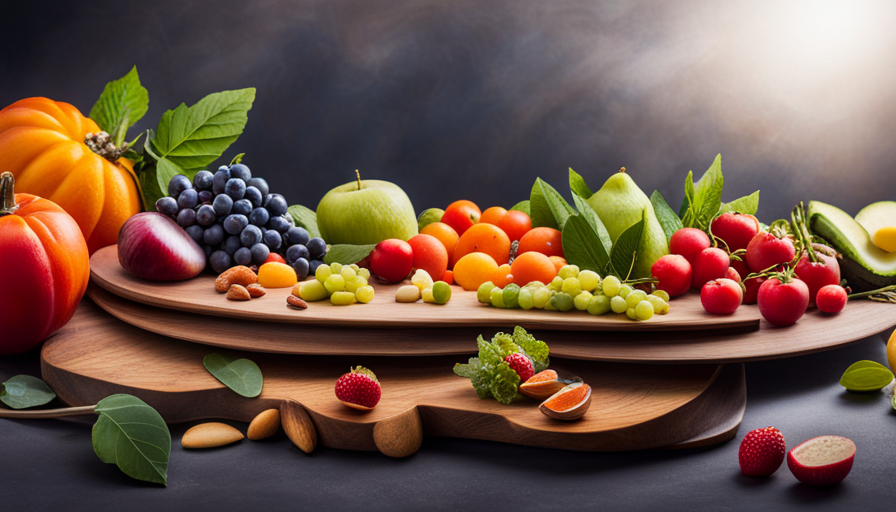What are the components of a raw food diet?
It’s a question many of us have asked ourselves as we seek out healthier eating habits. Well, let me tell you, a raw food diet is not your average diet. It’s a lifestyle that embraces the power of uncooked, unprocessed foods to nourish and heal our bodies.
So, what exactly does a raw food diet consist of?
It consists of a wide variety of fruits, vegetables, nuts, seeds, and sprouted grains. These foods are consumed in their natural, uncooked state, preserving their nutrients and enzymes. By avoiding cooking and processing, we can maximize the nutritional value of our food and experience a myriad of health benefits.
In this article, we’ll explore the definition of a raw food diet, the types of foods allowed, the benefits and challenges, and provide tips for starting this lifestyle. We’ll also include delicious recipes and meal ideas, success stories and testimonials, and expert opinions on the raw food diet.
So, if you’re ready to embark on a journey towards vibrant health and vitality, let’s dive into the world of raw food!
Key Takeaways
- A raw food diet consists of uncooked, unprocessed fruits, vegetables, nuts, seeds, and sprouted grains.
- It includes raw soups, smoothies, juices, nut milks, and desserts.
- The diet is rich in vitamins, minerals, and antioxidants, which supports a strong immune system and reduces the risk of chronic diseases.
- Pregnant women, children, and individuals with certain medical conditions should consult a healthcare professional before starting a raw food diet.
Definition of a Raw Food Diet
A raw food diet consists of eating uncooked fruits, vegetables, nuts, and seeds, which allows you to savor the vibrant colors and crisp textures of nature’s bounty. This way of eating is not just about consuming raw foods, but also about maximizing the nutrients and enzymes present in these foods through minimal processing and cooking.
Many people choose a raw food diet for its numerous health benefits. Research suggests that raw foods are rich in vitamins, minerals, and antioxidants that can support a strong immune system, reduce the risk of chronic diseases, and promote healthy digestion. Additionally, raw foods are typically lower in calories and higher in fiber, which can aid in weight management and promote a feeling of fullness.
However, there are some common misconceptions about a raw food diet. One misconception is that it is solely based on consuming salads and raw vegetables. While these foods are certainly a part of a raw food diet, there is a wide variety of other options available. Raw food enthusiasts also enjoy raw soups, smoothies, juices, nut milks, and even raw desserts. By incorporating a wide range of raw foods into your diet, you can ensure you are getting a diverse array of nutrients and flavors.
Now, let’s explore the types of foods allowed on a raw food diet.
Types of Foods Allowed on a Raw Food Diet
One major component of the raw food lifestyle is an abundant variety of fresh, uncooked fruits and vegetables. These foods aren’t just delicious but also provide essential nutrients for our bodies.
The types of fruits allowed on a raw food diet include apples, oranges, berries, and melons. These fruits are packed with vitamins, minerals, and antioxidants that help boost our immune system and promote overall health.
Additionally, vegetables play a crucial role in a raw food diet. Leafy greens such as spinach, kale, and lettuce are excellent sources of vitamins A, C, and K. Other vegetables like carrots, cucumbers, and bell peppers provide essential nutrients like beta-carotene and fiber.
Incorporating a variety of fruits and vegetables into a raw food diet ensures a well-rounded and balanced nutrient intake. By consuming these raw foods, we can reap the benefits of increased energy, improved digestion, and enhanced weight management.
Moving on to the next section about the benefits of a raw food diet, we’ll explore how these foods can positively impact our health and well-being.
Benefits of a Raw Food Diet
Packed with essential nutrients and bursting with flavor, a raw food lifestyle can revolutionize your health and leave you feeling vibrant and alive. The benefits of a raw food diet are numerous and significant.
Firstly, raw foods are rich in vitamins, minerals, and enzymes that can enhance your overall well-being. By consuming these foods in their natural state, you’re maximizing their nutritional value and reaping the benefits of their powerful antioxidants.
Additionally, a raw food diet can help in weight management and promote healthy digestion. Since raw foods are typically low in calories and high in fiber, they can aid in weight loss and improve your digestive health.
Furthermore, raw foods have been linked to a reduced risk of chronic diseases such as heart disease, diabetes, and certain types of cancer. The abundance of nutrients and antioxidants in raw foods can boost your immune system and protect against cellular damage.
Moreover, a raw food diet can increase your energy levels and improve your skin health. Many people report feeling more energetic, experiencing clearer skin, and even noticing a reduction in allergic reactions after adopting a raw food lifestyle.
While there are many potential benefits of a raw food diet, it’s important to be aware of the potential risks as well. Some people may experience difficulties meeting their nutritional needs, especially with regards to protein, calcium, and vitamin B12. It’s important to ensure you’re getting adequate amounts of these nutrients through careful meal planning or supplementation.
Additionally, a raw food diet may not be suitable for everyone, particularly pregnant women, children, and individuals with certain medical conditions. It’s advisable to consult with a healthcare professional before embarking on a raw food diet.
A raw food diet offers numerous benefits for overall health and well-being. However, it’s important to be mindful of the potential risks and take necessary precautions to ensure a balanced and nutritious diet. Transitioning to a raw food lifestyle can be challenging, but the rewards in terms of improved health and vitality are well worth it.
Now, let’s delve into the challenges of a raw food diet.
Challenges of a Raw Food Diet
Navigating the hurdles of a raw food lifestyle can be like embarking on an exhilarating adventure, where you’ll face the challenge of finding creative ways to meet your nutritional needs without cooking. While there are numerous benefits to a raw food diet, it is essential to acknowledge and address the challenges that come with it.
One of the main challenges of a raw food diet is meal preparation. With cooking out of the equation, it can be difficult to come up with interesting and satisfying meals that provide all the necessary nutrients. However, with careful planning and the right recipes, it is possible to create delicious and nutritious raw meals.
Another challenge is the potential health risks associated with a raw food diet. Raw food enthusiasts may be at a higher risk of foodborne illnesses due to the consumption of uncooked foods. It is crucial to ensure that all fruits, vegetables, and other raw ingredients are thoroughly washed and sourced from reputable suppliers.
Incorporating a 3 column and 3 row table in markdown format to engage the audience:
| Challenge | Solution |
|---|---|
| Lack of variety | Experiment with different fruits, vegetables, and herbs to create diverse flavors. |
| Nutrient deficiencies | Consult with a registered dietitian to develop a well-balanced raw food meal plan. |
| Time-consuming meal preparation | Utilize kitchen gadgets like food processors and dehydrators to simplify the process. |
Transitioning into the subsequent section about ‘tips for starting a raw food diet,’ it is important to address these challenges to ensure a successful transition into this lifestyle.
Tips for Starting a Raw Food Diet
Embarking on a raw food journey can be an exciting and fulfilling experience, and to ensure a successful start, here are some helpful tips for you.
-
Transition gradually: A sudden shift to a raw food diet can be challenging for your body. Start by incorporating more raw fruits, vegetables, and nuts into your meals while gradually reducing cooked and processed foods. This allows your body to adjust and prevents any sudden digestive discomfort.
-
Source local produce: To get the most out of your raw food diet, try to source fresh, local produce. Locally grown fruits and vegetables are usually picked at peak ripeness, which means they’re packed with nutrients and have a superior taste. Additionally, supporting local farmers helps reduce your carbon footprint and strengthens your community.
-
Experiment with recipes: Raw food doesn’t have to be boring! Explore various recipes and techniques to keep your meals interesting and satisfying. From vibrant salads to delicious smoothies and creative dehydrated snacks, there are countless options to explore. Get creative in the kitchen and discover new flavors and textures.
Transitioning gradually and sourcing local produce are essential aspects of starting a raw food diet. However, it’s important to be aware of potential risks and considerations when following this lifestyle.
Potential Risks and Considerations
When considering a raw food diet, there are several potential risks and considerations that should be taken into account.
One important consideration is the risk of nutrient deficiencies, as some essential nutrients may be lacking in a diet that primarily consists of raw foods.
Additionally, food safety concerns should be addressed, as raw foods have a higher risk of bacterial contamination.
Lastly, it’s important to recognize that individual variations and personal preferences play a significant role in determining the suitability and sustainability of a raw food diet for each person.
Nutrient deficiencies
Contrarily, adhering to a raw food diet may result in nutrient deficiencies if proper planning and supplementation are not considered. While raw fruits and vegetables are rich in vitamins and minerals, certain nutrients may be compromised due to the lack of cooking.
For example, vitamin B12 is primarily found in animal products, making it challenging for individuals following a raw vegan diet to obtain adequate amounts. A deficiency in B12 can lead to fatigue, nerve damage, and anemia.
Iron is another nutrient that may be lacking in a raw food diet. Plant-based sources of iron are not as easily absorbed by the body as animal-based sources, which may increase the risk of iron deficiency anemia in individuals on a raw food diet.
Calcium is also a concern for those on a raw food diet. These diets often exclude dairy products, which are a significant source of calcium. Inadequate calcium intake can contribute to weakened bones and an increased risk of osteoporosis.
Omega-3 fatty acids, essential fats predominantly found in fish and seafood, are difficult for raw food enthusiasts to obtain in sufficient amounts. Omega-3 deficiency can impact brain health and increase the risk of cardiovascular disease.
Considering these nutrient absorption challenges and potential long-term effects, it is essential for individuals on a raw food diet to carefully plan their meals and consider appropriate supplementation.
Transitioning into the subsequent section about food safety concerns, it is crucial to understand that while raw food diets have their benefits, there are also important considerations regarding food safety.
Food safety concerns
While nutrient deficiencies can be a concern on a raw food diet, it’s equally important to address food safety concerns. Since raw foods aren’t cooked, there’s a higher risk of potential pathogens, such as bacteria, viruses, and parasites, being present in the food.
To minimize this risk, it’s crucial to follow food safety guidelines. This includes proper washing of fruits and vegetables, thorough cleaning of utensils and cutting boards, and storing foods at the correct temperature. Additionally, it’s recommended to consume raw foods within their expiration dates and to avoid cross-contamination with other foods.
By following these guidelines, the risk of foodborne illnesses can be significantly reduced.
Transitioning into the subsequent section about individual variations and personal preferences, it’s important to note that everyone has unique dietary needs and preferences.
Individual variations and personal preferences
It’s important to remember that your unique dietary needs and personal preferences play a significant role in determining the right approach to your eating habits. When following a raw food diet, individual customization is key.
Here are three factors to consider when tailoring your raw food plan:
-
Dietary restrictions: Take into account any allergies, intolerances, or medical conditions that require you to avoid certain foods. For example, if you have a nut allergy, you may need to find alternative sources of protein and healthy fats.
-
Taste preferences: Some individuals may have specific taste preferences or aversions to certain foods. Experiment with different raw fruits, vegetables, nuts, and seeds to find combinations that you enjoy.
-
Nutritional requirements: Ensure that your raw food diet meets your nutritional needs, including an adequate intake of vitamins, minerals, protein, and essential fatty acids. Consider consulting a healthcare professional or registered dietitian to ensure you’re getting all the necessary nutrients.
Transitioning into the subsequent section about recipes and meal ideas for a raw food diet, exploring different options can help you find delicious and satisfying ways to incorporate raw foods into your daily meals.
Recipes and Meal Ideas for a Raw Food Diet
To add some excitement to your raw food diet, why not try making a delicious zucchini noodle salad with a creamy avocado dressing? This recipe isn’t just tasty but also packed with nutrients.
Start by spiralizing your zucchini into noodle-like strands. Then, toss them with diced tomatoes, sliced cucumbers, and chopped bell peppers for added crunch and color.
To make the dressing, blend ripe avocados with fresh lime juice, garlic, and a pinch of salt until smooth and creamy. Drizzle the dressing over the salad and garnish with chopped cilantro or basil.
If you’ve got a sweet tooth, there are plenty of raw food dessert recipes to satisfy your cravings. From raw chocolate mousse made with avocados and cacao powder to raw fruit tarts with a nut-based crust, the options are endless. These desserts don’t just taste amazing, but they also provide a host of health benefits.
In addition to being delicious, a raw food diet can also be beneficial for weight loss. Raw foods are typically low in calories and high in fiber, which can help you feel full and satisfied. They’re also packed with vitamins, minerals, and antioxidants that support overall health and well-being. Many people have experienced successful weight loss on a raw food diet.
Transitioning into the next section about success stories and testimonials, it’s inspiring to hear how others have transformed their lives through a raw food diet.
Success Stories and Testimonials
After exploring recipes and meal ideas for a raw food diet, I was blown away by the numerous success stories and testimonials I came across. People from all walks of life have shared their experiences of how adopting a raw food diet has transformed their health and well-being.
Many have reported weight loss, increased energy levels, improved digestion, and reduced inflammation. These success stories are not just anecdotal; there’s scientific evidence to support the health benefits of a raw food diet.
Research has shown that consuming a diet rich in raw fruits, vegetables, nuts, and seeds can lower the risk of chronic diseases such as heart disease, diabetes, and certain types of cancer. Raw foods are packed with essential nutrients, enzymes, and antioxidants that promote optimal health and boost the immune system. Additionally, the high fiber content of raw foods aids in digestion and helps maintain a healthy weight.
These success stories and the scientific evidence behind them make a compelling case for the raw food diet. It’s clear that this way of eating can lead to remarkable improvements in health and overall well-being.
As we delve into expert opinions on the raw food diet, we’ll discover even more fascinating insights into its benefits and potential drawbacks.
Expert Opinions on the Raw Food Diet
When it comes to the raw food diet, it’s important to consider the views of nutritionists and dietitians. These professionals can provide expert opinions on the benefits and potential drawbacks of this eating plan.
Additionally, research and scientific evidence are crucial in understanding the impact of a raw food diet on our health and well-being.
Views from nutritionists and dietitians
Nutritionists and dietitians are on the same page when it comes to the raw food diet – they both agree it’s like a refreshing and vibrant symphony for your body. They believe that consuming raw foods can provide a multitude of benefits, such as improved digestion, increased energy levels, and enhanced nutrient absorption. To illustrate this point, let’s take a look at a table that showcases the nutrients found in popular raw foods:
| Raw Food | Nutrients | Benefits |
|---|---|---|
| Spinach | Iron, Vitamin A, Vitamin K | Supports healthy blood and bone health |
| Almonds | Protein, Vitamin E, Magnesium | Promotes heart health and aids in weight management |
| Blueberries | Vitamin C, Fiber, Antioxidants | Boosts immune system and improves brain function |
These are just a few examples, but they demonstrate the wide variety of nutrients that can be obtained from a raw food diet. Transitioning into the next section about research and scientific evidence, it’s important to delve deeper into the studies that support these claims.
Research and scientific evidence
Numerous studies and scientific evidence have painted a vivid picture of the remarkable benefits that can be derived from adopting a raw food lifestyle. Research findings consistently show that a raw food diet is associated with improved digestion, increased energy levels, and weight loss.
Additionally, studies have demonstrated that this type of diet can reduce the risk of chronic diseases such as heart disease, diabetes, and certain types of cancer. The high nutrient content of raw foods, along with their natural enzymes and antioxidants, contribute to these health benefits.
Furthermore, research suggests that a raw food diet may also enhance the immune system, promote healthy skin, and improve overall mental well-being. These findings provide strong evidence supporting the adoption of a raw food lifestyle for optimal health and wellness.
Moving forward, it is important to consider the potential challenges and limitations of this diet in order to draw a well-rounded conclusion and final thoughts on the raw food diet.
Conclusion and Final Thoughts on the Raw Food Diet
Overall, you’ll find that the raw food diet offers a variety of health benefits, such as increased energy levels and improved digestion, making it a compelling option for those seeking a natural and nutrient-dense way of eating. However, it is important to consider the effectiveness and long-term sustainability of this diet.
Research on the effectiveness of the raw food diet has shown mixed results. While some studies have found positive effects, such as weight loss and improved blood lipid profiles, others have found no significant changes or even negative effects on certain nutrients like vitamin B12 and iron. It’s worth noting that most of the studies conducted on the raw food diet are observational and lack long-term follow-up.
In terms of long-term sustainability, the raw food diet can be challenging to maintain. It requires a significant amount of planning, preparation, and time commitment to ensure a balanced and varied intake of nutrients. Additionally, some individuals may find it difficult to meet their calorie needs on a raw food diet, leading to potential nutrient deficiencies.
While the raw food diet may offer some health benefits, it’s important to approach it with caution. Consulting with a healthcare professional or registered dietitian is recommended to ensure that all nutrient needs are being met. Furthermore, incorporating a variety of cooked and raw foods into your diet may provide a more balanced approach to nutrition and long-term sustainability.
Frequently Asked Questions
Are there any exceptions to the raw food diet?
There are exceptions to the raw food diet that need to be considered. While the diet typically consists of uncooked fruits, vegetables, nuts, and seeds, there are certain foods that should be avoided.
Raw meat, eggs, and dairy products can pose health risks due to the potential presence of harmful bacteria. Additionally, some people may find it challenging to meet their nutritional needs on a raw food diet, especially for certain vitamins and minerals that are more easily absorbed through cooking.
How long does it take to see the benefits of a raw food diet?
To see the benefits of a raw food diet, it typically takes some time and varies from person to person. It could range from a few weeks to a few months. The key is to gradually transition to a raw food diet to allow your body to adjust.
Start by incorporating more raw fruits, vegetables, nuts, and seeds into your meals while reducing processed and cooked foods. Remember to consult with a healthcare professional before making any significant dietary changes.
Can you eat cooked foods occasionally while on a raw food diet?
Yes, it’s possible to occasionally eat cooked foods while on a raw food diet. However, it’s important to note that the health benefits of a raw food diet come from consuming primarily raw, unprocessed foods. Cooking can alter the nutrient content of food, so choosing to eat cooked foods occasionally may reduce some of the benefits of a raw food diet. It’s best to focus on incorporating a variety of raw fruits, vegetables, nuts, and seeds into your diet for optimal health.
Can a raw food diet be sustainable for busy individuals with limited time for food preparation?
A raw food diet can be sustainable for busy individuals with limited time for food preparation. Meal planning is key to success in following a raw food diet for weight loss. By setting aside time to plan and prepare meals in advance, busy individuals can ensure they have nutritious and convenient options at hand.
Additionally, incorporating simple and quick recipes into the meal plan can help save time while still maintaining the principles of a raw food diet.
Is it necessary to take supplements while following a raw food diet?
Supplements aren’t necessary for everyone on a raw food diet. However, it’s important to assess individual nutrient needs and potential deficiencies. While a raw food diet can offer numerous health benefits, there are some risks associated with nutrient deficiencies, particularly vitamin B12, iron, and omega-3 fatty acids. Therefore, consulting a healthcare professional or registered dietitian is advised to ensure optimal health and prevent any potential health risks.
Can You Provide Specific Examples of Foods Included in the Raw Food Diet?
Sure, the principles of raw food diet emphasize consuming unprocessed, uncooked foods. Examples include fruits, vegetables, nuts, seeds, and sprouted grains. These foods are rich in nutrients and enzymes, believed to benefit overall health. Some raw foodists may also include fermented foods, like kimchi and kombucha, in their diet.
Conclusion
In conclusion, the raw food diet offers a natural and nutritious way of eating that can have numerous health benefits. By focusing on whole, unprocessed foods, this diet provides an abundance of vitamins, minerals, and enzymes that promote overall wellness.
However, it’s important to consider the challenges that come with this lifestyle, such as food preparation and potential nutrient deficiencies. With proper planning and education, individuals can successfully adopt a raw food diet and experience its positive effects on their health and well-being.










